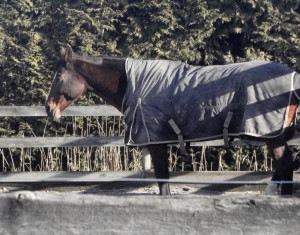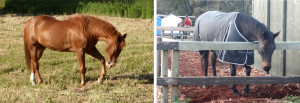Understand your Horse – Part 21
|
|
Ihr Pferd verstehen – Teil 21
|
The Legs
- We finished last time by looking at the feelings, which the horse can convey with the language of his tail.
- The language of the legs is not very complicated – and often the first thing a human is taught to watch for! “Don’t approach an unfamiliar horse from the back – watch for that cocked hind leg ready to kick!!”
1) Back leg lift:
- We have learned by now that horses always express themselves in phases of increasing intensity, giving you ample warning of their displeasure, before actually attempting to kick you. He would also not wish to kick you without a reason! If you DO give him reason… you’d better watch out for the previous phase, which would be the rump presentation – and clear out right then and there.
|
|
Die Beine
- Im letzten Teil haten wir am Ende die Gefühle betrachtet, die ein Pferd mit der Sprache seines Schweifes ausdrücken kann.
- Die Sprache der Beineist nicht sehr kompliziert – und oft das Erste, das wir zu beobachten lernen! „Geh nicht von hinten an ein Pferd heran – paß auf, wenn es sein Hinterbein zum Austreten anwinkelt!“
1) Hinterbein anheben:
- Wir haben ja bisher gelernt, daß Pferde sich immer in Phasen mit gesteigerter Intensität ausdrücken, so daß man genug Vorwarnung ihres Mißfallens erhält, bevor wirklich ein Tritt in unserer Richtung erfolgt. Auch würde ein Pferd nie ohne Grund auskeilen! Wenn Sie ihm Grund dazu geben… dann beobachten Sie lieber schon die vorige Phase, die das „Hintern-Präsentieren“ wäre – und verziehen Sie sich gleich da.
|
 Presenting the butt and lifting a hind leg are a warning that a kick will follow, if ignored.
Den Hintern präsentieren und ein Hinterbein anheben ist die Warnung, daß ein Tritt folgen wird falls nicht beachtet.
|
- The back leg lift is a defensive threat, which amplifies the rump presentation and announces a future kick, if ignored. Mares will also show this gesture gently to their foal, when it is too persistent at the udder and she does not want to nurse it.
- People who feel threatened by horses (mostly because of their size), such as little children, often mistake a “resting leg” of a snoozing horse for a back leg lift. Explain the difference to them, so they get a good start for their future horsemanship!
|
|
- Ein Anheben des Hinterbeins ist eine defensive Drohung, eine Verstärkung des Hinternpräsentieren, und verkündet ein zukünftiges Austreten, falls sie ignoriert wird. Stuten zeigen auch ihrem Fohlen diese Geste, wenn es am Euter zu zudringlich ist und sie es nicht säugen will.
- Menschen, die sich (meist wegen deren Größe) von Pferden bedroht fühlen, wie kleine Kinder zum Beispiel, mißverstehen oft ein angewinkeltes „ruhendes“ Hinterbein eines dösenden Pferdes als „Anheben“. Erklären Sie denen den Unterschied, so daß sie einen fröhlichen Anfang ihres Reiterlebens haben können!
|
 A leg kinked like this harbours no threat – this horse is asleep!
So ein angewinkeltes Bein ist keine Drohung – dieses Pferd schläft! |
2) Front leg lift:
- The front leg lift is also a movement showing intention. It is a mild version of a forward strike, which is of course used by horses when they fight. As a threat it is like a human shaking of the fist – leave me alone, or else!!
|
|
2) Anheben des Vorderbeins:
- Auch das Anheben eines Vorderbeines drückt eine Absicht aus. Es ist eine milde Form eines Ausschlagens nach vorne, welches bei kämpfenden Pferden üblich ist. Als Drohung ist es wie ein wütendes Faustschütteln eines Menschen – laß mich in Ruh, oder es kracht!
|
 Striking out a front leg is a gesture of fight – or like here: play! Front leg lifts are the milder form.
Nach vorn ausschlagen ist eine Kampfgeste – oder wie hier: Spiel! Ein Vorderbein anheben ist die mildere Form.
|
- But here too allow for horses to be much more friendly and peaceful that many people assume: many horses just show off this way – especially the ones who have learned the Spanish walk (which always makes them very proud!). Many horses use it as a gesture of begging for a treat – perhaps not the most desirable habit, as it can put your shins in danger and should therefore not be encouraged. Be observant and careful, yes, but try to be optimistic (rather than inherently negative, as we humans tend to be!) and do not see aggression, where it is actually not happening.
3) Pawing the ground:
- The origin of the pawing movement is of course the search for food. Feral horses must often look for grass under the snow or other cover, and this is their way of exploring the ground. For our horses in captivity it then becomes a symbolic gesture of frustration of a horse which begs for food (or attention), or is just bored and wants to get moving.
|
|
- Aber auch hier muß man in Betracht ziehen, daß Pferde generell viel friedliebender sind als viele Menschen denken: viele Pferde wollen nur angeben – vor allem, wenn sie den spanischen Schritt gelernt haben (der sie immer besonders stolz macht!). Viele Pferde betteln auch einfach so – vielleicht nicht eine wünschenswerte Gewohnheit, da es Ihre Schienbeine in Gefahr bringen kann, und man es daher nicht ermutigen sollte. Beobachten Sie also immer vorsichtig, aber seien Sie auch optimistisch (anstatt im Negativen verwurzelt wie wir Menschen nun mal sind!) und sehen Sie keine Aggression, wo keine besteht!
3) Scharren:
- Der Ursprung des Scharrens liegt in der Suche nach Futter. Pferde in der Wildbahn müssen oft unter Schnee oder anderem nach Gras suchen, und mit Scharren untersuchen sie den Boden. Für unsere Pferde in „Gefangenschaft“ wird es dann zu einer symbolischen Geste der Frustration eines Pferdes, welches um Futter (oder Aufmerksamkeit) bittet, oder welches einfach gelangweilt ist und sich bewegen will.
|
 Beau (left) is exploring the ground for food. The horse on the right is pawing with impatience to get out!
Beau (links) erkundet den Boden nach Futter. Das Pferd rechts scharrt, weil es raus will! |
- Pawing can be a very annoying habit, but it also does not happen without reason. I often see people who leave their horse in the cross-ties forever, while chatting with their friends – still finding time to reprimand their horse for pawing, but otherwise not paying attention to him. That is not fair! If you don’t intend to do something with or for him, don’t tie him up. Don’t think that he will “learn his lesson” by condemning him to boredom, while constantly shouting “no!” when he paws.
- Review the H.E.M. Blogs, where the “10 Laws of Shaping” (part 03 to 07) tell you how to TEACH your horse in the correct way with positive reinforcement! They also make it possible for you to un-train this bad habit of pawing. Make your horse’s life interesting – and he will not paw!
4) Stamping:
- Stamping is an up and down movement of a front leg. It is a mild movement of protest and as such will also often be shown by a mare to her foal, when she doesn’t like his behavior.
- If displayed to you – don’t ignore it! You should be grateful for a mild announcement of complaint, rather than an escalation. You often see it when horses are tied down and left in one spot for too long – this is boring! A horse needs to move! Avoid situations which go against your horse’s nature as much as possible and he will have no reason to protest in this way.
5) Knocking:
- By Knocking we mean a raising and lowering of a hind leg to make a forcible tapping sound. This too is a mildly threatening gesture, a “pre-kick announcement”.
- A lot of the mentioned leg movements are related to impatience and boredom. A horse has such a need to roam – and most of our horses suffer from a “motion deficit”- due to us! Feral horses walk for at least 6 km to 25 km every day while searching for food and water and visiting their places of rest – and most of our horses do not get enough exercise for their instinctual necessities. It makes a lot of sense that he will express the desire to get going with his legs! Don’t try and remedy those habits by punishment – change the situation and make his life more interesting.
In the next Blog we will listen… though most of the horse’s feelings will be expressed by body language, horses ARE able to communicate by sounds as well!
Read on!!
|
|
- Scharren kann eine sehr lästige Angewohnheit sein, aber auch das geschieht ja nicht ohne Grund. Ich sehe oft Leute, die ihre Pferde lange auf der Stallgasse angebunden stehen lassen, während sie mit ihren Bekannten schwatzen – aber dabei immer noch die Zeit finden, das Pferd fürs Scharren zu rügen, ohne ihm sonst irgendwelche Aufmerksamkeit zu schenken. Das ist nicht fair! Wenn Sie nicht vorhaben, etwas mit ihm zu tun, binden Sie es nicht an! Denken sie nicht, daß es „seine Lektion lernen“ wird, indem Sie es zu Langeweile verdammen, während sie dauern „nein!“ rufen, wenn es scharrt.
- In den H.E.M. Blogs, wo die „10 Gebote des Formens“ (Teil 03 bis 07) erklärt sind, lernen Sie, wie Sie das Pferd auf korrekte Art lehren – wie Sie ihm auch mit positiver Bestärkung so eine schlechte Angewohnheit abgewöhnen können. Gestalten Sie das Leben Ihres Pferdes interessant – und es wird nicht scharren!
4) Stampfen:
- Damit meinen wir ein Auf- und Abstampfen eines Vorderbeins. Es ist eine Bewegung des sanften Protestes und wird daher oft von einer Stute an ihr Fohlen gezeigt, wenn sie sein Benehmen mißbilligt.
- Wenn es an Sie gerichtet wird, ignorieren Sie es nicht! Sie sollten ja dankbar sein für eine milde Ankündigung einer Beschwerde anstatt einer prompten Eskalation. Auch das sieht man oft in Situationen, wo ein Pferd lange an einer Stelle angebunden stehen muß – das ist langweilig! Ein Pferd muß sich bewegen dürfen! Vermeiden Sie Situationen, die dem Pferd gegen die Natur gehen, so daß es keinen Grund hat, so zu protestieren.
5) Klopfen:
- Das ist ein mehrfaches Auf und Ab eines Hinterbeins, da einen kräftigen Klopflaut erzeugt. Auch das ist eine milde Drohung, die ein Auskeilen ankündigt.
- Viele der erwähnten Beinbewegungen haben mit Ungeduld und Langeweile zu tun. Ein Pferd hat so ein Bedürfnis zu wandern – und die meisten unserer Pferde leiden an Bewegungsmangel – unsere Schuld! Wildpferde laufen jeden Tag allein für die Suche nach Futter, Wasser und Rastplatz mindestens 6 km bis 25 km, und die meisten unserer Pferde bekommen nach ihren Instinkten nicht genug Bewegung. Es ist doch klar, daß sie ihren Bewegungsdrang mit den Beinen ausdrücken! Versuchen Sie nicht, diese Angewohnheiten durch Strafen zu uterdrücken – ändern Sie die Situation und machen Sie sein Leben interessanter.
Im nächsten Blog hören wir zu … denn obwohl Pferde die meisten ihrer Gefühle durch Körpersprache ausdrücken, sind sie dennoch auch fähig sich mit Lauten mitzuteilen!
Lesen Sie weiter!!
|
|
|
|
|





